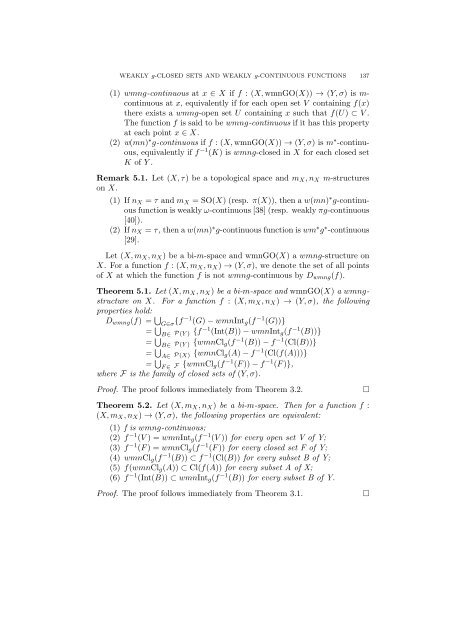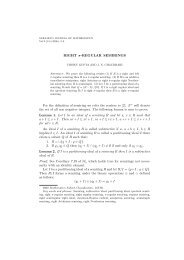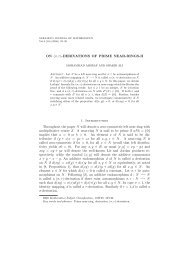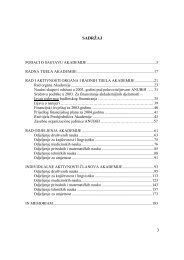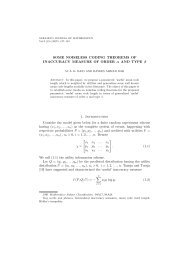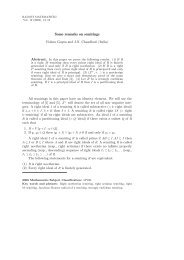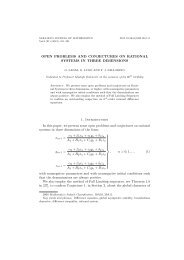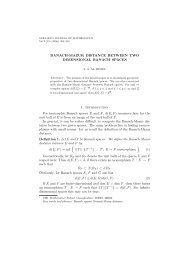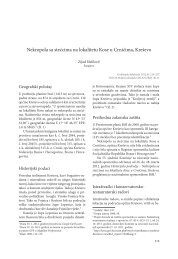Takashi Noiri and Valeriu Popa - anubih
Takashi Noiri and Valeriu Popa - anubih
Takashi Noiri and Valeriu Popa - anubih
You also want an ePaper? Increase the reach of your titles
YUMPU automatically turns print PDFs into web optimized ePapers that Google loves.
WEAKLY g-CLOSED SETS AND WEAKLY g-CONTINUOUS FUNCTIONS 137(1) wmng-continuous at x ∈ X if f : (X, wmnGO(X)) → (Y, σ) is m-continuous at x, equivalently if for each open set V containing f(x)there exists a wmng-open set U containing x such that f(U) ⊂ V .The function f is said to be wmng-continuous if it has this propertyat each point x ∈ X.(2) w(mn) ∗ g-continuous if f : (X, wmnGO(X)) → (Y, σ) is m ∗ -continuous,equivalently if f −1 (K) is wmng-closed in X for each closed setK of Y .Remark 5.1. Let (X, τ) be a topological space <strong>and</strong> m X , n X m-structureson X.(1) If n X = τ <strong>and</strong> m X = SO(X) (resp. π(X)), then a w(mn) ∗ g-continuousfunction is weakly ω-continuous [38] (resp. weakly πg-continuous[40]).(2) If n X = τ, then a w(mn) ∗ g-continuous function is wm ∗ g ∗ -continuous[29].Let (X, m X , n X ) be a bi-m-space <strong>and</strong> wmnGO(X) a wmng-structure onX. For a function f : (X, m X , n X ) → (Y, σ), we denote the set of all pointsof X at which the function f is not wmng-continuous by D wmng (f).Theorem 5.1. Let (X, m X , n X ) be a bi-m-space <strong>and</strong> wmnGO(X) a wmngstructureon X. For a function f : (X, m X , n X ) → (Y, σ), the followingproperties hold:D wmng (f) = ∪ G∈σ {f −1 (G) − wmnInt g (f −1 (G))}= ∪ B∈ P (Y ) {f −1 (Int(B)) − wmnInt g (f −1 (B))}= ∪ B∈ P (Y ) {wmnCl g (f −1 (B)) − f −1 (Cl(B))}= ∪ A∈ P (X) {wmnCl g (A) − f −1 (Cl(f(A)))}= ∪ F ∈ F {wmnCl g (f −1 (F )) − f −1 (F )},where F is the family of closed sets of (Y, σ).Proof. The proof follows immediately from Theorem 3.2.Theorem 5.2. Let (X, m X , n X ) be a bi-m-space. Then for a function f :(X, m X , n X ) → (Y, σ), the following properties are equivalent:(1) f is wmng-continuous;(2) f −1 (V ) = wmnInt g (f −1 (V )) for every open set V of Y;(3) f −1 (F ) = wmnCl g (f −1 (F )) for every closed set F of Y;(4) wmnCl g (f −1 (B)) ⊂ f −1 (Cl(B)) for every subset B of Y;(5) f(wmnCl g (A)) ⊂ Cl(f(A)) for every subset A of X;(6) f −1 (Int(B)) ⊂ wmnInt g (f −1 (B)) for every subset B of Y.Proof. The proof follows immediately from Theorem 3.1.□□


